





Today?s visit will take us to a botanical garden on Reunion Island, very different from the one we visited previously as this one is set in Pierrefonds, in the South-Western part of the island. Pierrefonds is quite harsh and if one drives rapidly by, he will mostly see sun-scorched boulders and yellowing grasses. But follow me and you will see how this is only a facade!
We are just a few miles from Saint-Pierre, the main town in the south, close to the small airport of Pierrefonds. There are--like anywhere on Reunion-the sugar-cane fields, some coconut trees and lots of drying plants in fallows. But if we drive on the ‘allée des cédres' we soon see a sign for ‘Domaine du Café Grillé', adorned with a giant coffee-pot, both emerging from a lush clump of blooming bougainvillea. We can park right in the front of a large building. The shade it provides is appreciated--it is only 9 a.m., but the heat is building! So let us get inside and have a look.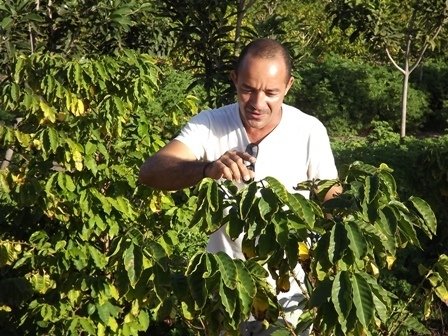 William in full explanation!
My friend William Luspot greats us on arrival; he is one of the kingpins of the garden, together with his father and mother, all great flora connoisseurs and lovers. Before starting the visit itself we will sit and sip some quality coffee while William will explain the ins and outs of the place. Now you do not just sit and order coffee, may I remind you this ‘Le Domaine du Café Grillé'? This means that those folks consider coffee as a special beverage, not simply a mood-booster or a social habit, you will have to choose between ‘Bourbon rond', ‘Bourbon pointu' and a choice of selected ones from Africa and Latin America. Both ‘Bourbon' coffees are locally grown (Reunion island was called ‘île Bourbon' during king times), the ‘rond' (from its rounded beans) is grown, harvested, sun-dried and roasted on the premises with some 3,500 plants while the ‘pointu' (pointed beans, as you might guess) comes from growers uphill as it requires coolness. You can enjoy your cup either on a stool at the ‘café la savanne' inside the vast hall where local crafts and plants from the attached nursery are on display. Or you can sit outside on a comfortable wood bench. So as my friend told you, this is an ethnobotanical garden which means it is not just a display of various plant species arranged in a clever and aesthetic way but also a garden where plants are related to the history and life on Reunion. The planted area is 4 hectares (40,000 square meters), hosting 600 to 800 different species and numbering some 10,000 trees and shrubs; plenty to enjoy. Is everyone ready to proceed? Hats on the head and cameras in hand, let us go.
William in full explanation!
My friend William Luspot greats us on arrival; he is one of the kingpins of the garden, together with his father and mother, all great flora connoisseurs and lovers. Before starting the visit itself we will sit and sip some quality coffee while William will explain the ins and outs of the place. Now you do not just sit and order coffee, may I remind you this ‘Le Domaine du Café Grillé'? This means that those folks consider coffee as a special beverage, not simply a mood-booster or a social habit, you will have to choose between ‘Bourbon rond', ‘Bourbon pointu' and a choice of selected ones from Africa and Latin America. Both ‘Bourbon' coffees are locally grown (Reunion island was called ‘île Bourbon' during king times), the ‘rond' (from its rounded beans) is grown, harvested, sun-dried and roasted on the premises with some 3,500 plants while the ‘pointu' (pointed beans, as you might guess) comes from growers uphill as it requires coolness. You can enjoy your cup either on a stool at the ‘café la savanne' inside the vast hall where local crafts and plants from the attached nursery are on display. Or you can sit outside on a comfortable wood bench. So as my friend told you, this is an ethnobotanical garden which means it is not just a display of various plant species arranged in a clever and aesthetic way but also a garden where plants are related to the history and life on Reunion. The planted area is 4 hectares (40,000 square meters), hosting 600 to 800 different species and numbering some 10,000 trees and shrubs; plenty to enjoy. Is everyone ready to proceed? Hats on the head and cameras in hand, let us go.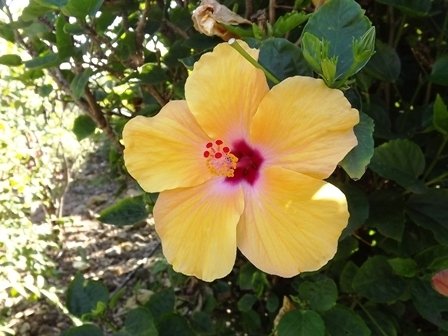
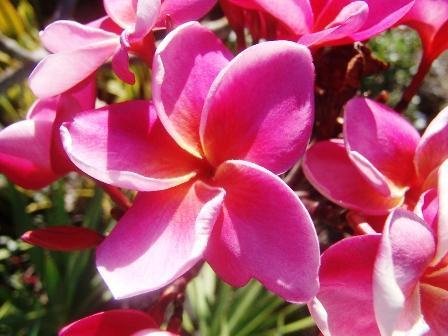 Hibiscus rosa-sinensis
Plumeria rubra
ornamental with the useful (hence roses and hibiscus intertwined with salads and mango trees.) This ornamental zone is divided in various kinds of garden; xerophytic (drought-resistant species) with many plants originating from South Africa and Madagascar, vines, colored foliage bushes arranged to blend shapes and shades, a palm tree garden, a shaded one and so forth. We can enjoy here and there some rather common tropical flowers such as Hibiscus rosa-sinensis and Plumeria rubra which nonetheless can stop anyone in its tracks with the bright colors and unique perfume. Lesser known plants are this nice climber with large fragrant white flowers, Beaumontia grandiflora of the Apocynaceae family or this cute Otacanthus caeruleus of the Scrophulariaceae family known in English as ‘Brazilian snapdragon' (guess where it comes from?) Its vibrant blue flowers with a white heart are just delicious. Growing no higher than 3 feet (90cm), it requires a moist environment and well-drained soils, will do fine in partially sunny to bright filtered spots and may adorn the basis of larger shrubs or amongst boulders, it has naturalized on the Eastern coast of Reunion.
Hibiscus rosa-sinensis
Plumeria rubra
ornamental with the useful (hence roses and hibiscus intertwined with salads and mango trees.) This ornamental zone is divided in various kinds of garden; xerophytic (drought-resistant species) with many plants originating from South Africa and Madagascar, vines, colored foliage bushes arranged to blend shapes and shades, a palm tree garden, a shaded one and so forth. We can enjoy here and there some rather common tropical flowers such as Hibiscus rosa-sinensis and Plumeria rubra which nonetheless can stop anyone in its tracks with the bright colors and unique perfume. Lesser known plants are this nice climber with large fragrant white flowers, Beaumontia grandiflora of the Apocynaceae family or this cute Otacanthus caeruleus of the Scrophulariaceae family known in English as ‘Brazilian snapdragon' (guess where it comes from?) Its vibrant blue flowers with a white heart are just delicious. Growing no higher than 3 feet (90cm), it requires a moist environment and well-drained soils, will do fine in partially sunny to bright filtered spots and may adorn the basis of larger shrubs or amongst boulders, it has naturalized on the Eastern coast of Reunion. 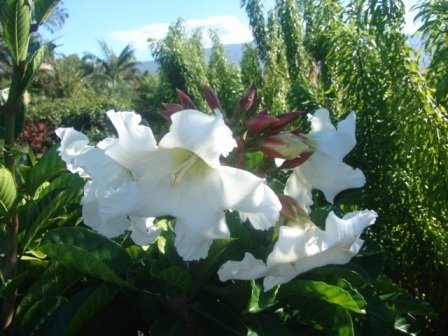
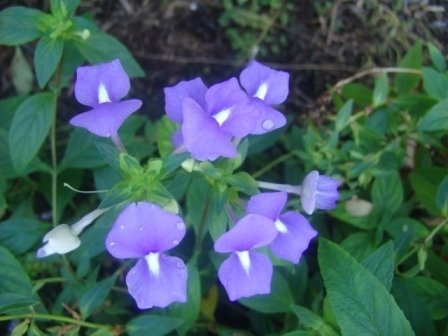 Beaumontia grandiflora
Otacanthus caeruleus
fantastic plant which deserves to be better known and used in gardens, a representative of theh Acanthus family, (one of my favorite families), Aphelandra sinclairianais one of the 170 or so species within the genus! This one originates from Central America, will reach 6 to 10 feet (1.80 to 3m) and will produce long-lasting erect spikes or orange bracts while the flowers themselves are short lived two-lipped pink ones. It does fine in full sun to partially shaded spots. A post now invites us in a bamboo grove where we can sit on a bench and meditate or simply rest. Do have a look at this incredible stem yellow with dark green vertical strips, they really look like some mad
Beaumontia grandiflora
Otacanthus caeruleus
fantastic plant which deserves to be better known and used in gardens, a representative of theh Acanthus family, (one of my favorite families), Aphelandra sinclairianais one of the 170 or so species within the genus! This one originates from Central America, will reach 6 to 10 feet (1.80 to 3m) and will produce long-lasting erect spikes or orange bracts while the flowers themselves are short lived two-lipped pink ones. It does fine in full sun to partially shaded spots. A post now invites us in a bamboo grove where we can sit on a bench and meditate or simply rest. Do have a look at this incredible stem yellow with dark green vertical strips, they really look like some mad
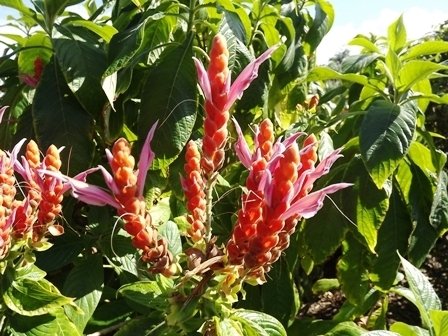
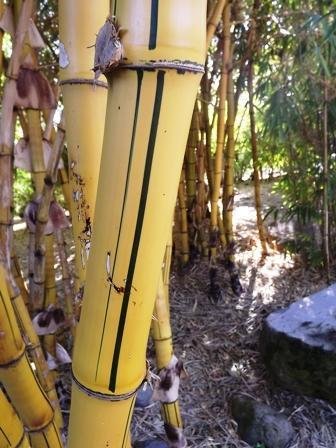 Aphelandra sinclairaina
Painted bamboo
artist just painted them, if you look carefully you even see at both extremities a slight deviation just like a brush would have done, no surprise the local name is ‘bambou la peinture' (paint bamboo) while for us Latin speakers this is Bambusa vulgaris ‘Vittata'. Various species are grown here thought you will not find Dendrocalamus giganteus as it is too invasive and water greedy but it is nonetheless grown on the island where its purpose was in former times to be used as water pipes for irrigation. Right after this meditative halt we reach the palm trees, a fine collection of species from nearby Madagascar, Africa, Asia, Australia, and of course our very own endemic ones from the Mascareignes archipelago. The very impressive Neodypsis decaryi from Madagascar is the only palm tree to display an isosceles triangle formed by the palms insertions, the grey-bluish color of the leaflets adds to its decorative aspect. Another already massive one, also from Madagascar is Raphia farinifera, known on Reunion as ‘mouffia' that has been extensively grown as it yields fiber which was widely used for ropes, the trunk can reach 30 feet (10m) high and the leaves 60 feet (20m) long, the longest leaves among vegetal reign. Now a very strange and extremely rare one, Socratea exorrhiza
Aphelandra sinclairaina
Painted bamboo
artist just painted them, if you look carefully you even see at both extremities a slight deviation just like a brush would have done, no surprise the local name is ‘bambou la peinture' (paint bamboo) while for us Latin speakers this is Bambusa vulgaris ‘Vittata'. Various species are grown here thought you will not find Dendrocalamus giganteus as it is too invasive and water greedy but it is nonetheless grown on the island where its purpose was in former times to be used as water pipes for irrigation. Right after this meditative halt we reach the palm trees, a fine collection of species from nearby Madagascar, Africa, Asia, Australia, and of course our very own endemic ones from the Mascareignes archipelago. The very impressive Neodypsis decaryi from Madagascar is the only palm tree to display an isosceles triangle formed by the palms insertions, the grey-bluish color of the leaflets adds to its decorative aspect. Another already massive one, also from Madagascar is Raphia farinifera, known on Reunion as ‘mouffia' that has been extensively grown as it yields fiber which was widely used for ropes, the trunk can reach 30 feet (10m) high and the leaves 60 feet (20m) long, the longest leaves among vegetal reign. Now a very strange and extremely rare one, Socratea exorrhiza
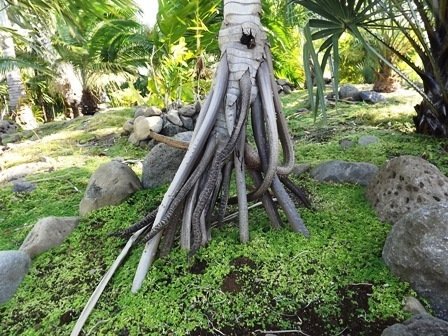 Socratea exorrhiza
comes from Central America and produces stilt roots, the story is that the tree grows new roots towards one direction and the older ones die back, thus allowing the plant to slowly move across the jungle floor but this is subject to debate...Dictyosperma album (hurricane palm) and Acanthophoenix rubra (barbel palm) are both endemics to Reunion and Mauritius and both grown for the edible cabbage they produce which explains why they also have disappeared in the wild. They are too yummy to live freely! These two guys cleverly open way to the fruit trees part of the garden with a mere 160 different species, so we can now try some exotic tastes. Here is one of the best known of tropical fruits, the banana, Musa x paradisiaca
Socratea exorrhiza
comes from Central America and produces stilt roots, the story is that the tree grows new roots towards one direction and the older ones die back, thus allowing the plant to slowly move across the jungle floor but this is subject to debate...Dictyosperma album (hurricane palm) and Acanthophoenix rubra (barbel palm) are both endemics to Reunion and Mauritius and both grown for the edible cabbage they produce which explains why they also have disappeared in the wild. They are too yummy to live freely! These two guys cleverly open way to the fruit trees part of the garden with a mere 160 different species, so we can now try some exotic tastes. Here is one of the best known of tropical fruits, the banana, Musa x paradisiaca
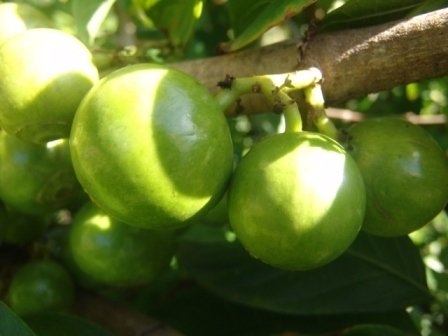
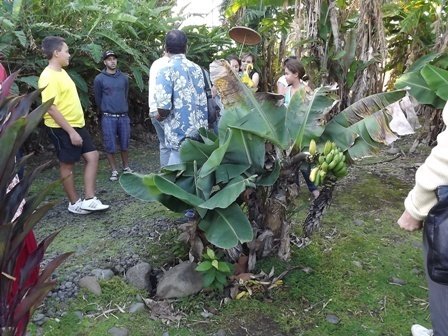 Vangueria madagascariensis
Super-dwarf banana tree and greedy visitors!
but although banana trees are a very common feature all over the tropics this one here is a curiosity as it is a dwarf one. Dwarf bananas are known but a dwarf Cavendish will still reach some 10 feet (3m)
Vangueria madagascariensis
Super-dwarf banana tree and greedy visitors!
but although banana trees are a very common feature all over the tropics this one here is a curiosity as it is a dwarf one. Dwarf bananas are known but a dwarf Cavendish will still reach some 10 feet (3m)
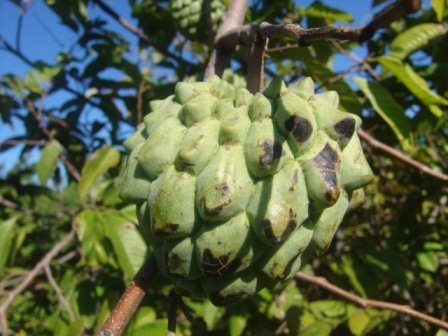
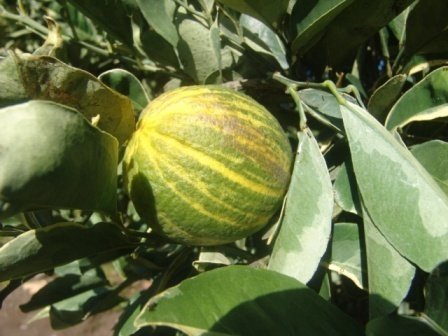 Annona cherimolia
Variagated citrus
while this one is barely 3 feet (1m) high. Although grown in open ground and it does bear fruits, a great idea for small gardens. Less common is this variegated orange tree (Citrus sinensis) which foliage is variegated as one can guess but the fruits themselves bear green and white strips, my friend William also states that the juice itself is variegated but I have not yet checked this out to be sure! This strange-looking fruit with an alien aspect is a custard apple, Annona cerimolia originating from South America. No resemblance whatsoever with an apple, the soft skin contains a creamy pulp surrounding many black seeds and a single fruit can weight up to 2kg if hand-pollinated. The connoisseurs among you might be surprised to see this plant here as it supposedly only grows at altitudes between 2400 and 4500 feet (800 and 1500m) but folks here have special green thumbs...Now a small fruit rarely seen out of Reunion, Madagascar and to some extent East Africa, the ‘vavangue' or Spanish tamarind comes from Madagascar and is nowadays naturalized on Reunion where it is pretty popular. A member of the Rubiaceae family (like coffee) Vangueria madagascariensis is a bush growing to 9 to 12 feet (3 or 4m) much branching which does bear round glossy green fruits ripening brown with an acid taste, they are not very tasty nor juicy but are an indefectible part of Reunionese culture.
Annona cherimolia
Variagated citrus
while this one is barely 3 feet (1m) high. Although grown in open ground and it does bear fruits, a great idea for small gardens. Less common is this variegated orange tree (Citrus sinensis) which foliage is variegated as one can guess but the fruits themselves bear green and white strips, my friend William also states that the juice itself is variegated but I have not yet checked this out to be sure! This strange-looking fruit with an alien aspect is a custard apple, Annona cerimolia originating from South America. No resemblance whatsoever with an apple, the soft skin contains a creamy pulp surrounding many black seeds and a single fruit can weight up to 2kg if hand-pollinated. The connoisseurs among you might be surprised to see this plant here as it supposedly only grows at altitudes between 2400 and 4500 feet (800 and 1500m) but folks here have special green thumbs...Now a small fruit rarely seen out of Reunion, Madagascar and to some extent East Africa, the ‘vavangue' or Spanish tamarind comes from Madagascar and is nowadays naturalized on Reunion where it is pretty popular. A member of the Rubiaceae family (like coffee) Vangueria madagascariensis is a bush growing to 9 to 12 feet (3 or 4m) much branching which does bear round glossy green fruits ripening brown with an acid taste, they are not very tasty nor juicy but are an indefectible part of Reunionese culture.
Copyright © www.100flowers.win Botanic Garden All Rights Reserved